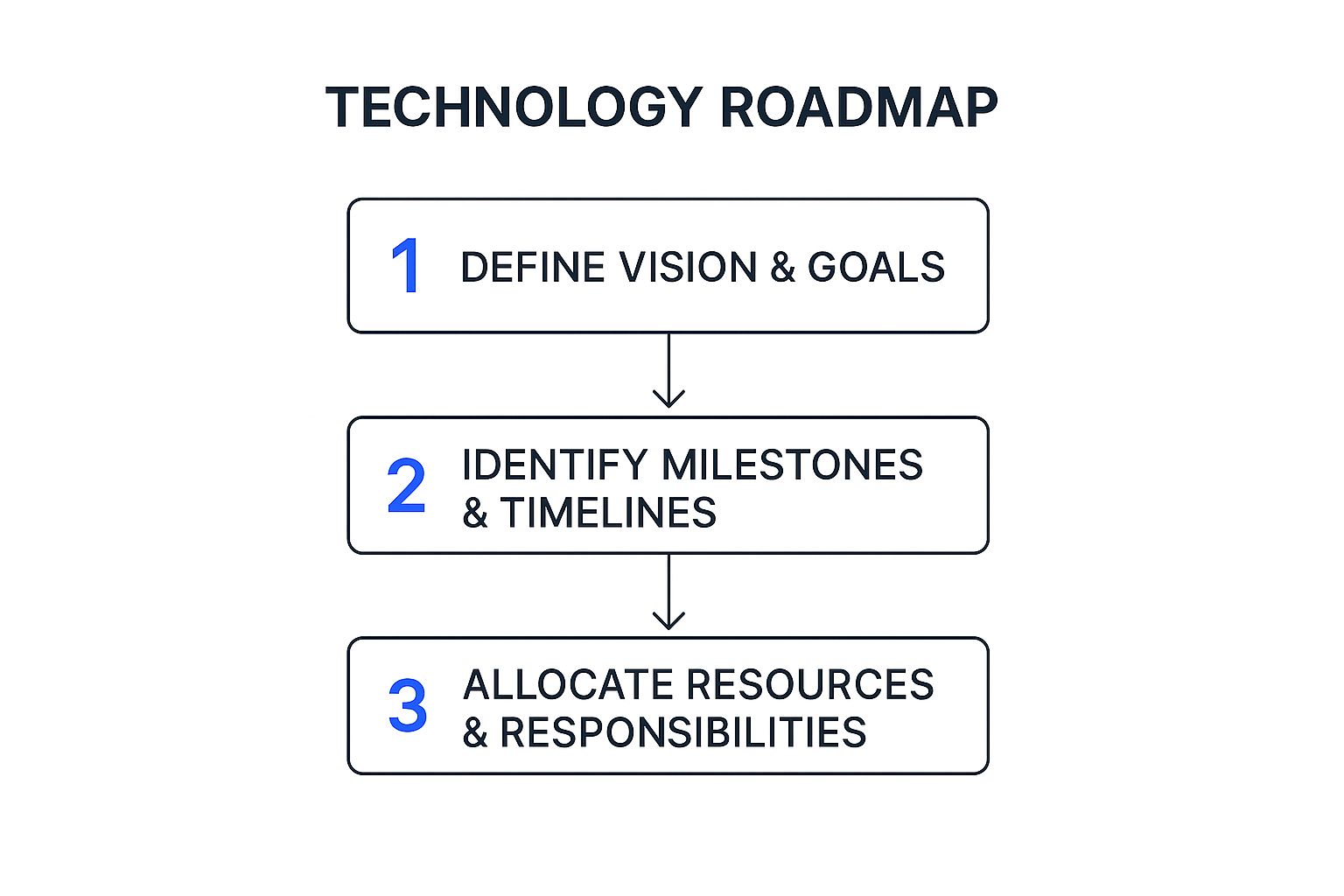A technology roadmap is a simple but powerful document. It’s a strategic plan that lays out how your agency’s tech investments will actually help you hit your long-term business goals. Think of it as a high-level visual guide that gets everyone-from your creative team to the leadership-on the same page, ensuring all your tech efforts are pulling in the same direction.
Why Your Agency Needs a Technology Roadmap
For so many creative agencies, buying technology is a reactive scramble. A new client demands a specific platform, or a project management tool is picked in a mad rush to solve an immediate problem. It might feel agile in the moment, but this approach almost always leads to a tangled mess of disconnected software, climbing costs, and seriously frustrated teams.
Breaking that cycle is absolutely essential for any kind of sustainable growth.
A well-planned technology roadmap shifts your approach from reactive to strategic. It becomes your North Star, making sure every new software subscription, hardware upgrade, and system integration serves a clear purpose. This isn't just some IT document to be filed away; it's a core part of your agency's business strategy.
Shift from Chaos to Clarity
Let's imagine two creative agencies. Agency A is making it up as they go. They buy new software whenever a project screams for it, leaving them with multiple project management tools, redundant file-sharing subscriptions, and a design team wrestling with incompatible software. Their profit margins are getting squeezed, and technical glitches constantly delay projects. It’s pure chaos.
Agency B, on the other hand, uses a technology roadmap. They planned six months ahead to roll out a single, unified project management system that integrates with their financial software. Their team is efficient, client onboarding is seamless, and their profitability is way up because they've cut out wasted spending and lost time. That clarity didn't happen by accident-it was the direct result of strategic planning.
A technology roadmap is the difference between letting technology dictate your agency’s direction and using technology to drive it. It aligns your investments with your vision, turning your tech stack into a competitive advantage instead of a financial drain.
Tangible Business Benefits
When you put a technology roadmap in place, you start seeing real, measurable improvements across the business. The most obvious benefit is financial. It stops those impulsive purchases and cuts down on "shadow IT"-where teams use unapproved software, creating security risks and blowing the budget. A planned approach can slash software spending by up to 30% just by getting rid of redundant tools.
Beyond the cost savings, a roadmap delivers so much more:
- Improved Efficiency: When your tools actually talk to each other, your team spends less time fighting with software and more time doing brilliant creative work.
- Enhanced Client Satisfaction: A stable, efficient tech stack means you can deliver high-quality work on time, every single time. That builds trust and keeps clients coming back.
- Reduced Technical Debt: Proactive planning helps you avoid those quick fixes that inevitably create bigger headaches down the line, ensuring your systems stay robust and can scale with you.
To get a head start on structuring your own plan, checking out a proven digital transformation roadmap template can be incredibly helpful. Ultimately, this strategic document is about empowering your team to deliver exceptional work by giving them the right tools at the right time.
Defining Your Strategic Technology Goals

A technology roadmap without a clear destination is just an expensive shopping list. Before you even think about specific software or shiny new hardware, you have to get brutally honest about what you’re trying to achieve. The whole process kicks off by turning vague business ambitions into concrete, measurable technology goals.
This first stage is all about people and conversations-not code. It's about uncovering what really matters to your agency right now. Is the big push for faster production turnarounds to onboard more clients? Or is tightening up data security the absolute top priority to protect high-profile client work? Maybe it's about time you properly integrated AI to unlock a whole new service offering.
These goals can't be decided in an IT silo. A roadmap built solely by the tech team is destined to fail because it won’t solve the real-world problems of the people using the tools day in, day out.
Uncovering Agency-Wide Priorities
The only way to figure out your true priorities is to talk to key people from every corner of your agency. This means running collaborative workshops or, even better, focused one-on-one interviews.
Sit down with your department heads-creative, accounts, operations, and finance. Ask them direct questions that get beyond surface-level complaints and into the real grit of their daily work.
- What’s the single biggest point of friction in your team’s daily workflow?
- If you had a magic wand, what one process would you fix immediately?
- Where are we losing time or money because of clunky, inefficient systems?
- What opportunity are we missing out on because our current tech just can’t support it?
The answers will reveal patterns. You might hear that the account team wastes hours manually pulling reports that could be automated, or that the design team is constantly held back by slow rendering times on ageing hardware. These are the problems your technology roadmap must solve.
For more hands-on advice during this crucial alignment phase, our detailed guide on building a digital transformation roadmap offers some invaluable next steps.
Getting this cross-departmental buy-in from the very beginning isn't just nice to have; it's non-negotiable. When everyone feels heard, the final roadmap becomes a shared vision for the agency’s future-not just an IT department's wish list.
From Ambition to Actionable Objectives
Once you've gathered all this input, the next job is to translate those broad needs into solid, actionable goals. This involves connecting the dots between what the business wants to achieve and the technology required to make it happen.
To give you a clearer idea, here is a simple framework for mapping your agency's goals to specific tech solutions and the metrics you'll use to track success.
Mapping Agency Goals to Technology Solutions
| Agency Goal | Potential Technology Solution | Key Success Metric |
|---|---|---|
| Increase project profitability | Automated time-tracking and project management software (e.g., Asana, Forecast) | 15% reduction in non-billable hours within 6 months |
| Enhance client collaboration | A secure, centralised client portal for file sharing and feedback (e.g., Frame.io, Filestage) | 25% faster client approval times on creative assets |
| Improve creative workflow efficiency | Upgraded high-performance workstations and cloud-based rendering services | 50% reduction in average file rendering time |
| Strengthen data security | Implementation of Multi-Factor Authentication (MFA) and a team-wide password manager (e.g., Bitwarden) | Zero security incidents involving compromised credentials over 12 months |
This kind of mapping ensures every initiative on your technology roadmap has a clear purpose and directly supports the business. By defining these goals upfront, you create the essential foundation for a plan that delivers real, measurable results for your agency.
How to Audit Your Current Tech Stack

Before you can build a meaningful technology roadmap, you need a painfully honest look at what you’re already using. An audit isn't about blaming people for bad choices; it's about creating a clear-eyed, factual baseline of every piece of tech your agency relies on.
The goal here is a complete inventory. This process shines a light on everything-the obvious software subscriptions, the hardware gathering dust in a corner, and even the unofficial 'shadow IT' tools teams use just to get their work done. This is the only way to ensure your future investments solve real problems instead of just adding more complexity.
Cataloguing Every Tool and Subscription
First things first: you need to create a master list of your entire technology stack. And I mean exhaustive. Don't just tick off the big-ticket items like your project management platform or the team’s Adobe Creative Cloud licences. You have to dig much deeper.
For instance, a creative studio might list its primary design tools but completely forget about a niche font library subscription, a social media scheduling app used by only one team, or a file-transfer service someone pays for on their personal credit card. These small costs not only add up but often expose hidden gaps in your official processes.
To get a complete picture, you need to:
- Follow the money: Comb through company credit card statements, supplier invoices, and your accounting software to find every recurring tech payment. No matter how small.
- Survey your team: Send out a simple survey asking every single person to list all the software, apps, and online services they use for work-both the official tools and the ones they've adopted on their own.
- Check your physical assets: Create a straightforward inventory of all company-owned hardware. This includes laptops, monitors, servers, and networking gear. Make a quick note of their age and general condition.
Evaluating Real-World Effectiveness
With your complete inventory in hand, the real analysis begins. A long list of tools doesn’t tell you if they're actually working for you. The next step is to judge each item based on its real-world use and value to the agency. This is where you move from a simple list to gathering qualitative data.
It's not enough to know what you have; you need to understand how it's being used-or not used. An underutilised tool is just as problematic as a missing one, representing wasted money and a missed opportunity for efficiency.
To figure out what’s effective, start asking tough questions about every tool on your list:
- Utilisation: What percentage of the team actively uses this? Is it central to their workflow, or is it an occasional nice-to-have? Be honest.
- Redundancy: Does this tool do the same job as another system we're already paying for? For example, are teams using both WeTransfer and Dropbox to share large files?
- Performance: Does this tech actually speed us up, or does it slow us down? Are there constant complaints about it being buggy, slow, or just plain difficult to use?
- Cost vs. Value: Is the price we pay for this tool truly justified by the value it brings to our projects, our team, and our clients?
This audit gives you the raw data you need for your technology roadmap. It provides a clear picture of what to keep, what to get rid of, and where your biggest gaps lie. It ensures your plan is built on reality, not just wishful thinking.
Building Your Phased Implementation Plan
You’ve defined your strategic goals and audited your current tech. Now for the hard part: turning that vision into a concrete, actionable plan. A successful technology roadmap isn't built on a single, giant leap; it’s a series of well-planned, manageable steps that make ambitious projects feel achievable and build momentum along the way.
As you get into the nitty-gritty, remember that the whole point of a roadmap is turning vision into reality. A strategy on paper is just that-paper. Without a clear path to execution, it’s useless.
This is where you shift from the "what" and "why" to the "how" and "when." Breaking down the implementation into logical phases prevents your team from becoming overwhelmed and, crucially, minimises disruption to critical client work. For a more detailed look, our guide on the 5 steps to build a technology roadmap is an excellent resource to have open.
Prioritising Initiatives With MoSCoW
One of the most powerful frameworks I've seen teams use for this is the MoSCoW method. It's a simple but effective way to force decisive choices about where to focus your resources first, creating a clear hierarchy of needs.
The method organises every potential project into four distinct categories:
- Must-Have: These are your non-negotiables. Think of things that are critical for your agency’s operations or security. A real-world example would be replacing a legacy server that’s constantly failing or implementing a new security protocol to meet client compliance requirements. You can’t put these off.
- Should-Have: These are important but not immediately vital for survival. A new, integrated project management system might fall into this category. It would absolutely improve efficiency, but your current setup can limp along for a few more months if needed.
- Could-Have: These are the desirable "nice-to-have" additions. They'd improve things, but the impact is smaller. This could be a new AI-powered tool for generating creative concepts or upgrading everyone's monitors. They’re great, but they’re not essentials.
- Won't-Have (This Time): This category is just as important as the others. It explicitly tables certain projects for the current planning cycle, freeing up focus and resources for the priorities you’ve actually set.
Using this framework helps you slice up your budget and your team's time, dedicating them to the tasks that deliver the most immediate value. It's all about creating short-term wins that build support and enthusiasm for the longer-term vision.
The whole process, from big ideas to getting it done, often follows a natural flow, as this visual guide shows.

It’s a clear illustration of how defining your vision logically leads to setting milestones and allocating the resources needed to hit them.
Setting Realistic Timelines and Milestones
With your priorities locked in, you can start building a timeline. The key word here is realistic. Assign clear milestones that act as checkpoints to keep everyone on track and accountable.
For instance, phasing in a new project management system shouldn't be a one-day "big bang" event. A smarter approach would look something like this:
- Phase 1 (Month 1-2): Final selection, purchase, and the core technical setup. Get a small pilot group from one team to test the system on a single, low-risk project.
- Phase 2 (Month 3-4): Roll out agency-wide training sessions. The system is then used for all new projects, while existing work is completed on the old platform to avoid chaos.
- Phase 3 (Month 5-6): Full migration. All active projects are now moved over to the new system, and the old platform is officially switched off and decommissioned.
This staged rollout minimises disruption and gives your team time to adapt without feeling overwhelmed. It’s a smart, sustainable way to make big changes stick.
Communicating the Road Map to Your Team

Even the most carefully crafted technology roadmap is useless if it just sits in a spreadsheet or a boardroom folder. A plan that nobody understands or believes in is just a document. Its real power is only unlocked when every single person in your agency gets what it is, why it matters, and how it’s going to make their day-to-day work better.
This means you can’t just fire off an email with a link and cross your fingers. You need to tell a compelling story around the roadmap, and that story needs to change depending on who you’re talking to. Your leadership team is thinking about ROI and competitive edge. Your creative team, on the other hand, wants to know how a new tool will impact their workflow and whether it’s going to help or hinder their creativity.
Tailoring Your Message for Maximum Impact
Think of presenting your roadmap less like a technical briefing and more like a pitch. You are selling a vision. The trick is to translate abstract goals into tangible, real-world benefits for each part of your team, and to get ahead of their questions before they even ask.
- For Leadership & C-Suite: Stick to the "why." Connect every single initiative back to core business goals like boosting profitability, cutting down client churn, or improving data security. Use the hard numbers from your audit to show them the cost of doing nothing.
- For Project & Account Managers: This is all about efficiency. Show them how new, integrated systems will slash manual admin, automate tedious reporting, and make client approvals smoother. It’s about freeing them up for more valuable, strategic work.
- For the Creative Team: Frame it as empowerment. Position new tools as a way to kill friction, speed up soul-destroying tasks like rendering or file wrangling, and ultimately give them more time and headspace to do what they love-create amazing work.
To make sure everyone is on the same page, building out a project communications plan template can provide a solid framework for scheduling these vital conversations and keeping the messaging consistent.
A great technology roadmap isn't just presented once; it's socialised continuously. Your goal is to create an ongoing dialogue, not a one-time announcement. This approach turns team members from passive recipients into active participants in the agency's evolution.
Establishing a Rhythm of Communication
Once you’ve done the big reveal, the real communication work begins. To keep the roadmap from becoming another forgotten initiative, you need a steady rhythm of updates and check-ins. This isn't about micromanaging; it's about maintaining momentum and being transparent, which are foundational to effective project management for agencies.
Set up a simple, consistent schedule. A quick progress update in your monthly all-hands meeting, a dedicated Slack channel for questions and feedback, and celebrating the wins as you hit milestones are all great tactics.
When your team sees actual progress and feels like their feedback is genuinely being heard, they stay invested. This is how you turn a static document into a living, breathing guide that truly directs your agency's future.
Got Questions About Your Tech Roadmap?
Even with the best plan in the world, you’re bound to have questions crop up as you start building and using a technology roadmap. It’s a natural part of the process. Here are some of the most common queries we hear from creative agencies, along with some straight-talking, practical answers to keep you moving forward.
How Often Should We Be Tweaking Our Roadmap?
Think of your technology roadmap as a living document, not something you carve in stone and forget about. It's a guide that needs regular course correction to stay relevant. For most creative agencies, a full review every six months hits the sweet spot.
But some things just can't wait for a scheduled check-in. You should trigger an immediate review if:
- Your business strategy takes a sharp turn – like deciding to chase a new market or launching a totally new service.
- A game-changing piece of tech emerges that could genuinely give you a competitive edge.
- You get unexpected (and loud) feedback from your team about a tool that just isn't cutting it.
The aim here is to be responsive without creating chaos. A six-month cycle gives you stability, while ad-hoc reviews provide the agility to adapt when it really matters.
The best roadmaps strike a fine balance between a long-term vision and short-term flexibility. They’re firm on the goals but fluid in the execution, letting you jump on new opportunities without completely derailing your core strategy.
How Do We Actually Measure the ROI of This Thing?
Proving the return on investment (ROI) is essential. It’s how you justify the effort and secure the budget for next time. The trick is to look beyond simple cost savings and track a mix of hard numbers and softer, but equally important, metrics.
- The Hard Numbers (Quantitative): This is the stuff your finance team loves. Track things like a 15% drop in time spent on admin tasks, a 10% boost in project profitability, or a 20% cut in software subscription costs after you’ve ditched redundant tools.
- The Human Impact (Qualitative): This measures how your team feels and how the quality of work improves. Simple surveys can track boosts in team morale, how well people are collaborating, and their general satisfaction with the tools they have to use every single day.
This data-driven mindset is becoming more and more vital. Economic analysis shows just how important it is, with the data economy now making up between 3.0% and 6.7% of all UK economic activity. We’ve already seen how initiatives like Open Banking have helped 77% of users manage their finances better by making data easier to access. You can read the UK government's 2024 Smart Data Roadmap for more on how this is driving growth.
What If the Team Pushes Back on Change?
Let’s be honest: resistance from the team is one of the biggest hurdles you'll face. It’s almost never about the technology itself. It’s about the fear of disruption, the uncertainty, or simply the hassle of learning something new. The only way through it is with clear, consistent, and empathetic communication.
A great first step is to find your "champions" in each team-those tech-savvy people who are genuinely enthusiastic about the changes. Get them involved in testing and decision-making, and then let them help support their colleagues.
Most importantly, you need to relentlessly focus on the "what's in it for me?" for every single person. Show your designers how a new server will slash their render times in half. Prove to your account managers how a new CRM will wipe out hours of manual reporting. When people see how a change makes their own day-to-day work better, resistance almost always melts away and turns into support.
At InfraZen Ltd, we live and breathe this stuff. We specialise in creating and managing technology roadmaps that are perfectly aligned with the unique pulse of creative agencies. We sort out the technical complexity behind the scenes, so your team can stay focused on what they do best-producing incredible work.
Learn how our strategic IT services can bring clarity and efficiency to your agency.

